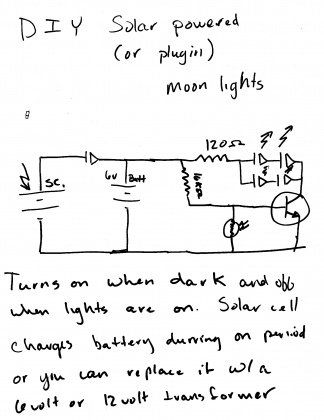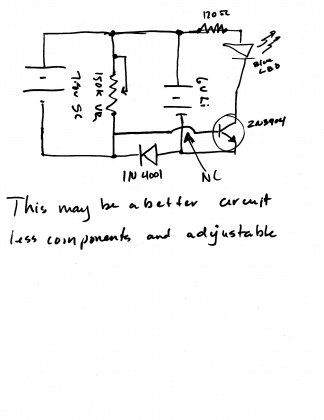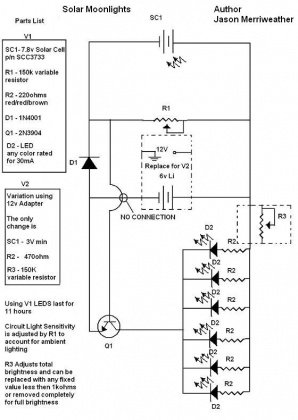Sorry about the title i want to be specific here is my design for a solar or wall powered moonlight that comes on when the main light go out and turn off when the main lights come back on (self timed). I think you guys are really gonna like this. Ill post pics as i complete it. The circuit is still in testing stages and i havent confirmed the resistence values 100% yet.
You are using an out of date browser. It may not display this or other websites correctly.
You should upgrade or use an alternative browser.
You should upgrade or use an alternative browser.
DIY Solar powered or ac powered moonlight schematic
- Thread starter Jnam
- Start date
The friendliest place on the web for anyone with an interest in aquariums or fish keeping!
If you have answers, please help by responding to the unanswered posts.
If you have answers, please help by responding to the unanswered posts.
The circuit is a self loop and can be modified to accept a 6 volt DC supply from a wall charger.
the solar powered version, the solar cell sits just above your lights and charges the NiCd batteries all day when it goes dark the batteries supply the current to the lights. Pretty simple.
THink night light for your fish!!
the solar powered version, the solar cell sits just above your lights and charges the NiCd batteries all day when it goes dark the batteries supply the current to the lights. Pretty simple.
THink night light for your fish!!
2cvbloke
Aquarium Advice FINatic
the solar powered version, the solar cell sits just above your lights and charges the NiCd batteries all day when it goes dark the batteries supply the current to the lights. Pretty simple.
I see a flaw...
If the solar panel/cell is on top of your tank, it won't charge the batteries effectively, as they have to be in direct sunlight to operate at their full voltage (which for 6v could be about 8-10V), and there are few tanks that sit in direct sunlight. If you mean that the panel sits just above the tank lights and face the lights, that too wouldn't work, yes it'll generate some electricity, but not enough to be used for what you plan on doing...
The easiest solution to this is to site a small panel outdoors, facing due south (or north for those South of the equator), run a wire to the batteries (simple speaker wire would suffice for a small panel) through a relay, when the panel voltage drops, the relay cuts out and turns on the lights, it's just finding a suitable relay for the job...
The solar cell is inside the canopy, with me PC lighting using a 50/50 bulb the scc3776 solar cell is putting out 7.8 volts and 42mA which durring a 12-14 hour period of light, is enough to charge the 6volt NiCd batteries to run for the 6-10 hours at night without any problems. I use these same solar cells in my photovoltaic robots and the work wonderfully. The only problem I am having is using the NiCd batteries i may need to change to a more effecient rechargable, or i may use a large capacitor disharged through a resistor as the "battery" itll give the moonlight a nice fade as the power tapers off. the LEDs are on the 460 nM wave length. But i am olso adding a feature where the light can be plugged in which would eliminate the solar and battery set up. Even with an expensive reflector the light saturation caps out at about 85% so why not use the other 15% or so of power loss to run your moon lights? LEDs take such a small amount of current to run vs their light output its very hard to beat their effeciency. Even if the solar cell was only able to partialy charge the batteries that would account for more than enough "juice" needed to run 4 LEDs.
I completed the test circuit last night its charging as we speak ill test the batteries when i get home tonight to see what kind of charge they recvd. To make it a fair test i drained teh NiCds to almost empty. So we'll see.
I completed the test circuit last night its charging as we speak ill test the batteries when i get home tonight to see what kind of charge they recvd. To make it a fair test i drained teh NiCds to almost empty. So we'll see.
relays are horribly ineffecient the coil in them takes far to much energy. A simple npn transistor does the job with the solar cell her is a pic of your idea a little modified to account for the relay idea. I think the circuit may be better deffinately more effecient and sensitive to light change than a cds cell in this scenario the solar cell is outside facing south so as the sun sets the light come on. or it could be in the canopy and when lights out leds are on. the 150k allows to adjust for sensitivity and the less componenets the better HEH
Attachments
Last edited:
Justin_Toronto
Aquarium Advice Activist
- Joined
- Sep 8, 2008
- Messages
- 172
So what ended up happening with the project?
Sorry forgot to update. Works fantastic. I went with the solar powered version. With 8 1/4 watt LEDS the battery chage lasts for 8 hours before the clamping voltage drops on the q1 transistor. which works perfect... The 10 hour charge time (how long my light are on at full spectrum) keeps the batteries at about a consistant 80% charge. I am toying with using a more effeciently chargeable LiPo battery well see how that goes. I used the second schematic. Instead of using a photoresistor (terrible sensitivity) i use the solar cell to turn off and on the lights. the adjustment allows me to set the sensitivity so that when i enter the room and turn the light on the moonlights dont turn off. Feel free to use the schematic for personal use.
Sure -- I'm sure others are interested and it'll be nice to have in AA's archives later. I'm thinking of using white LEDs, which while it doesn't have the reported invisibility (I call BS) to fish as blue LED, I hope it will help me see the tank at night in a more natural way. Right now my best option is incandescent ambient light :/
Thanks!
Thanks!
Here is the final schematic for your viewing pleasure
Assuming a 30ma rating for the LEDs and a required voltage drop of .7v you can calculate the resistor values of R2 with this formula:
(Supply Voltage - .7)/0.03 = value of resistor in ohms.
or
(supply voltage - voltage drop of LED)/(required current value for LED) = resistor value
this will allow you to use which ever LEDs you wish and still not burn em out.
I would round up to the neares common value you can find.
R3 can be adjusted too far and cause a null 0v no light you can also use a 10k trimpot to make it smaller and fit better on a PCB.
Q1 can be replaced with any simalar small signal NPN transistor.
once i solder all the components to the PCB I epoxied the whole thing except the two variable resistors nice and water tight. Same thing at the connections for the LEDS.
I mounted the LEDS to a thin strip of PVC drilled holes to fit just the LEDs and then mounted that to the underside of my light. HTH
Assuming a 30ma rating for the LEDs and a required voltage drop of .7v you can calculate the resistor values of R2 with this formula:
(Supply Voltage - .7)/0.03 = value of resistor in ohms.
or
(supply voltage - voltage drop of LED)/(required current value for LED) = resistor value
this will allow you to use which ever LEDs you wish and still not burn em out.
I would round up to the neares common value you can find.
R3 can be adjusted too far and cause a null 0v no light you can also use a 10k trimpot to make it smaller and fit better on a PCB.
Q1 can be replaced with any simalar small signal NPN transistor.
once i solder all the components to the PCB I epoxied the whole thing except the two variable resistors nice and water tight. Same thing at the connections for the LEDS.
I mounted the LEDS to a thin strip of PVC drilled holes to fit just the LEDs and then mounted that to the underside of my light. HTH
Attachments
Similar threads
- Replies
- 1
- Views
- 2K
- Replies
- 9
- Views
- 801
Latest posts
-
-
-
Nitrates up, pH and total alkalinity down
- Latest: Airborne 82nd
-
-
-



